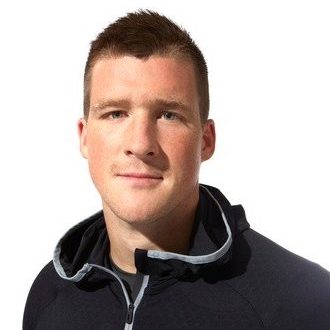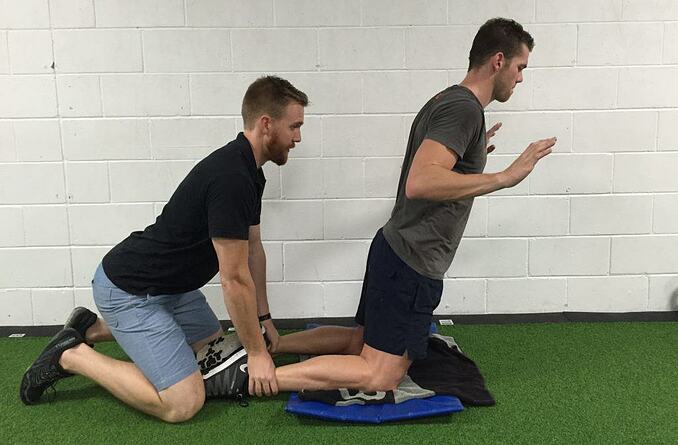6 Functional Movements Every Athlete Should Master
ABOUT THE AUTHOR

Mike Dewar
Mike holds a Masters in Applied Physiology from Columbia University and a Bachelors in Exercise Science from Bowling Green State University. He is an accredited Strength and Conditioning Specialist (NSCAS CSCS) from the National Strength and Conditioning Association and an Advanced Sports Performance Coach from USA Weightlifting (USAWL2).
// What Does “Functional” Even Mean?!
Believe it or not, Mayo Clinic came out with a pretty dang good definition of a term that is overly saturated within our industry these days….
“Functional exercises train your muscles to work together and prepare them for daily tasks by simulating common movements you might do at home, at work or in sports. While using various muscles in the upper and lower body at the same time, functional fitness exercises also emphasize core stability.”
The term functional can be adapted to anything really, as long as the purpose is clearly defined and can relate to what a coach envisions will integrate the entire body and human movement patterns necessary for life, work, and sport.


// Why Do Them?
These exercises are pretty established (and effective) for creating bulletproof athletes, specifically for joints that are injury prone (knees, shoulders, backs, etc.).
These movements are challenging variations of common lifts that increase core stability and mobility demands. They can enhance overall performance when done at moderate loading with the highest emphasis on movement integrity rather than heavier loading.
// Who Should Do These?
Generally speaking, I feel that nearly every athlete can benefit from the list of exercises below.
Whether they are throwers, runners, lifters, or anywhere in between, increasing strength and mobility throughout the fullest ranges of motion achievable is key, with the acknowledgment that many of us are not as mobile as we need to be to ensure proper joint movement and fluidity. The above link can help you take care of that!
// When To Do Them
As weightlifters, powerlifters, sports athletes, and CrossFitters, we have a plethora of training variations and attributes that must be trained. Prioritization of training exercises is key, and it can often be difficult to find movements that offer us the most bang for our buck.
The below movements are standard exercises seen in my functional strength and fitness program, which was developed to provide my Olympic weightlifting team, sports and recreational athletes (baseball, track and field, wrestling), and clients a way to build muscle and move better.


For in-season athletes, functional fitness is key to injury prevention, movement integrity, and stimulation for enhancing recovery as the intensity is often lower in loading due to greater necessities for core strength, balance, and movement integrity.
Another great way to build these into current training regimens is to perform them during lighter days, active rest days, and warm-up circuits. Or simply insert them as assistance lifts in place of “standard movements” like dumbbell pressing, side lunges, planks, etc.
// Six functional movements every athlete should master
1. Z Presses
The kettlebell Z press (which can also be done with the barbell, dumbbell, or other forms of external loading) can be very beneficial for shoulder and upper back strength, spinal stability, and scapular health.
When performing the Z press, throwers and other overhead athletes (as well as all athletes, regardless of sport) are forced to stabilize with the rhomboids and posterior shoulder to allow for smooth repetitions vertically. I find it best to actually coach this movement as a “reach” rather than a press, stating that the movement originates from the upper back and has the lifter brace, sit up tall, and reach the loads up and over the head.
Below is a clear exercise demo on the kettlebell Z press. This one is specifically done with asymmetrical loading to further the degree of difficulty and stability needed. The key here is to lengthen the spine, contract the core, and focus on pressing the heels downwards in the press.
You have some flexibility with how many repetitions and sets you want to use. I suggest treating this movement like any other pressing movement, making sure to keep lighter loads and reinforce sound body awareness and tension prior to loading this up with more weight.
2. Weighted Holds and Carries
Whether these are farmer’s carries, yoke walks, D-bag holds, stones, or partner work, loaded holds, carries, and other loaded movement pieces are essential for helping athletes understand confident movement skill, and even allow for supramax loading in some instances which can drive some serious strength and performance.
This can help athletes brace and increase spinal awareness, core strength, and tension during the squat. deadlift, and even press.
Below is a video demo of a standard loaded movement. The flexibility of this exercise allows for constant variations to be made (mentioned above) resulting in a broader ability to handle and react to unfamiliar loads and forces.
Programming loaded movements is a wide open topic; however, it does truly depend on the exercise selected, purpose (recovery or aggressive work), and the ability of the athlete.
I typically will stick to time under tension protocols for hypertrophy and do holds/carries with 45-75 total seconds of work. Another way is to have athletes do sets during training sessions or simply as a paired exercise.
3. Cossack Squats
The Cossack squat can work to increase hip, knee, and ankle mobility, strengthen the glutes, and work the critical muscles that protect the knee from lateral forces.
Unlike the side lunge, this squat variation really forces an athlete to work the hip throughout the entirety of the end range, which is important for runners, wrestlers, and other full range of motion athletes.
By increasing the dynamic strength and mobility of the hips, hamstrings, and other lower body structures, you allow for better movement in exercises like squats and human movement as a whole.
Below is a video demo of the double front rack Cossack squat/slide (presses added too, however, not needed for normal Cossack squat/slide), which can also be done with no weight, assisted (straps), barbell, or any other common exercise variation.
Be sure to keep the hips set at the same level, and as you start to increase repetitions and range of motion, slowly reset that hip height to a lower level.
I really like pairing these in warm-up progressions or movement days (active recovery or in-season movement pieces) as they can be done with little to no weights and still challenge end range joint control and stability in injury-prone joints (ankle, knees, and hip).
Sets of 10 or so per leg are a good start, with heavier loading of 3-5 repetitions for more strength and hypertrophy work as well. The key is to focus on the movement, feeling fluid, and not sacrificing proper joint mechanics and control for heavier loads (squats make us strong…so use Cossack squats to help you MOVE better).
4. Nordic Hamstring Curls
Hamstring health is such a huge issue for runners, track and field, football, baseball, soccer, weightlifters, etc.
The amount of force we typically expel during open-chained movements on the field or under heavy loading and high velocities during training sessions makes the hamstrings highly susceptible to strains and other injuries. Many coaches understand this and program a steady diet of stiff-legged deadlifts, unilateral hip hinge training, hamstring curls, and more.
The Nordic hamstring curl allows coaches to load the ECCENTRIC portion of the lift, which is key to increasing the tensile strength and resistance to strain during explosive movements where the hips and quadriceps kick into full force mode. Nordic curls have been shown to increase eccentric strength at all velocities and even help decrease hamstring strains.
The two charts below document those findings, thanks to strength training research Instagram star, Chris Beardsley.
These are pretty brutal, so easing into this movement is highly recommended. Doing slow and control-assisted lifters can help athletes to allow their hamstrings to relax and train the full range.
Once an athlete has established confidence, perform 2-4 sets of 8-12 repetitions once or twice per week.
5. Chasing the “Pump”
Call it what you will, but basic bodybuilding and hypertrophy movements done at a lower to moderate intensity can do wonders for blood flow and clearance of by-product. Plus, it’s a great way to add training volume to your athletes (the more work he/she can do, the better).
The chart below summarizes a study that found there may not be as much to it as we think, other than simply chasing the muscle pump to elicit blood flow response and anabolic triggering, cellular swelling, hypertrophy, etc.
A wide array of sets, reps, tempos, and other training variables can be manipulated to elicit results. Keeping hypertrophy sessions moving is the key, trying to keep rest periods 30-60 seconds with moderate to heavy loads (60-75% RM).
6. Turkish Get-Up


The Turkish get-up is an exercise that can enforce sound hip mobility, core stabilization, and shoulder mobility/stability all at once.
Coaches should take the time to teach and progress athletes properly with Turkish get-ups (and the variations, discussed in the post below). By increasing one’s ability to stabilize loads under a wide array of angles (as an athlete progresses throughout the get-up) you can increase proprioception, coordination, and the strength of many smaller stabilizers of injury-prone joints (shoulders, hips, elbows, wrists, etc).
When starting out, coaches should assess proper shoulder health, mobility, strength, and body awareness using mobility training, arm bars, half get-ups, kneeling presses, windmills, and reverse get ups.
Once this has happened, Turkish get-ups should be an easy progression for an athlete to make. Reps and loading should be kept moderate – with the underrating, the loading should be heavy enough where an athlete cannot rush through the steps and get away with poor shoulder integrity, yet light enough to minimize the risk of injury. Only as an athlete progresses should heavier loads be handled.
Are you a better coach after reading this?
More coaches and athletes than ever are reading the TrainHeroic blog, and it’s our mission to support them with useful training & coaching content. If you found this article useful, please take a moment to share it on social media, engage with the author, and link to this article on your own blog or any forums you post on.
Be Your Best,
TrainHeroic Content Team
HEROIC SOCIAL
HEROIC SOCIAL
TRAINING LAB
Access the latest articles, reviews, and case studies from the top strength and conditioning minds in the TH Training Lab

